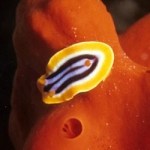feeding
Nudibranchs -- marine snails without shells -- make wonderful photo subjects for the macro photographer. They are small, colorful, and they move slowly (as snails are wont to do). That last characteristic is particularly welcome. Most fishes are in motion almost constantly, and non-sessile invertebrates tend to scurry hither and thither. It's nice to find a subject that is not only photogenic, but doesn't turn tail or flat out disappear before the photographer can focus the camera's lens!
It's always interesting to find out and record which critters feed on what. Here are some macro…
A pod of Orcas surrounds a seal on an ice sheet and creates waves to try and knock it off. This reminds me of when you buy a candy bar and it gets stuck by the wrapper and you have to shake the machine to get it out.
Thanks to Zooillogix reader extraordinaire Don Quixjote (aka ali) for forwarding along.
tags: parrots, feeding
One of the great pleasures I have is feeding my birds. I love everything about it, from shopping for the finest and freshest foods to preparing them for the birds to eat. As a result, I'd guess that my food preparations for the birds become rather complicated. Anyway, I thought I'd let you all know what my birds are eating this week;
All the birds;
frozen, thawed mixed vegetables (peas, carrot pieces, corn, lima beans)
fresh zucchini pieces
fresh red bell pepper pieces
fresh corn-on-the-cob cut into 1-inch "wheels"
fresh gala apple pieces
fresh mango pieces
fresh orange…
tags: parrots, aviculture, conservation, personal story
Things are going well with the parrots, especially the new hawk-headed parrot (this bird has been living with me for one week and one day now). As I already mentioned several times, this bird is eating on his(her?) own now, although I still handfeed the bird each evening before we all go to sleep.
Speaking of food, this little bird is as eager an eater as any of my birds are. This morning, for example, I gave all my birds their breakfast* and the hawkheaded parrot immediately dove in to the bowl, head-first and began eating. Elektra,…
Mandarin Goby, Synchiropus splendidus
Researchers from James Cook University in North Queensland, Australia have made a startling discovery: gobies intentionally deprive themselves of food to avoid conflict with their rulers. Goby society is lorded over by the largest males and females and these are the only individuals allowed to breed. If a smaller goby tries to jump the queue and mate, it will be expelled from the group by the bigger fish. However, all is not peaches and cream at the top, as competition between the larger fish to establish dominance is fierce. Therefore, smaller gobies…
But I just want to cuddle! Bathynomus giganteus
In what might be described as the world's most destructive termite problem, Hotboro Island is actually being eaten away by isopods only about an inch long. Isopods are not in fact insects, but primitive crustaceans ranging in size from the size of a pin to the size of a bowling ball. Inhabitants of neighboring Higohihiroshima had been noting the steady erosion of the island for years. After each tsunami, parts of the island would break off and disappear. When scientists finally examined the remnants of the island last year, they found isopods…
Army-ants storm through the jungles of Panama a million strong devouring any and every living creature in their path. Some clever birds have found a way to capitalize on the mayhem: Stay close to the ants and eat the leaping, running, and scampering insects that attempt to escape.
Who would want to escape from this love fest?
Antbirds and ovenbirds, the main ant-following species, have different strategies for using the ants to their advantages. Some birds only follow the ants within their own territories, but stop when they reach the borders. Others dabble in ant following, hitting them up…
